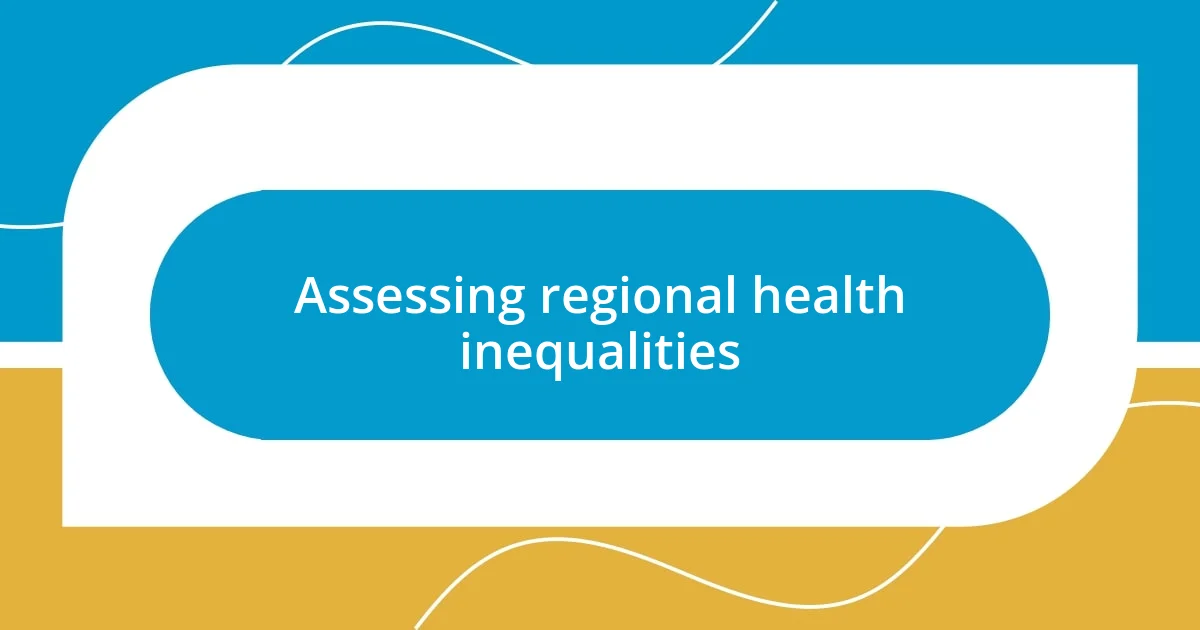Key takeaways:
- NHS health disparities highlight the unequal access to healthcare and varying outcomes based on factors such as geography, socioeconomic status, and educational attainment.
- Socioeconomic status significantly impacts health, with financial barriers leading to poorer access, nutritional choices, and living conditions that contribute to overall health disparities.
- Future NHS policies should focus on data-driven approaches, community collaboration, and incorporating the voices of underserved communities to create effective and equitable healthcare solutions.

Understanding NHS health disparities
NHS health disparities reveal a troubling divide in healthcare access and outcomes across different population groups. I remember a friend of mine, who faced significant barriers to healthcare access due to where she lived—a stark reminder of how geography can limit one’s ability to receive timely treatment. It’s staggering to think that some people in urban areas enjoy cutting-edge medical facilities, while those in rural areas may struggle to find a GP.
Understanding these disparities means examining the intersection of socioeconomic factors, race, and even education. Have you ever wondered how income impacts health? During my time volunteering at a local clinic, I witnessed firsthand how financial strain compounded health issues; individuals would delay seeking help simply because they couldn’t afford the bus fare to get there. This kind of insight illustrates the real-life implications of these disparities and challenges us to think critically about the systems in play.
Moreover, it’s not just about access to services—outcomes reveal a great deal about the quality of care provided. I once spoke with a mother who noticed that her children were often overlooked during consultations, leading to missed diagnoses. Shouldn’t all patients feel seen and heard in the NHS? This kind of personal experience emphasizes the emotional toll of disparities and reinforces the urgent need for reform to ensure equitable healthcare for every individual.

Key factors influencing health disparities
Health disparities in the NHS arise from various influential factors. For instance, I remember a visit to a community health center where I met a gentleman whose chronic condition went unmanaged due to his work schedule. His job required long hours with little flexibility, making it nearly impossible for him to attend regular appointments. This highlights how employment status can drastically affect health access and, ultimately, health outcomes.
Another key aspect influencing these disparities is educational attainment. I’ve seen how individuals with lower levels of education often struggle to navigate the complex healthcare system. In conversations with patients, they frequently express confusion about treatment plans or medication use—sometimes even fearing to ask questions due to a perceived lack of understanding. This illustrates how education plays a vital role in a person’s ability to advocate for their own health.
Lastly, it’s essential to consider the impact of social and community support. During my time engaging with marginalized communities, I noticed a strong connection between a supportive network and improved health outcomes. For example, in one neighborhood, residents organized regular health workshops that not only informed their peers but also created a sense of belonging. This engagement shows how social cohesion can bridge some of the gaps caused by disparities.
| Key Factors | Examples |
|---|---|
| Employment Status | Long hours leading to missed healthcare appointments |
| Education Level | Difficulty in understanding and navigating the healthcare system |
| Community Support | Health workshops promoting engagement and knowledge sharing |

Impact of socioeconomic status
Socioeconomic status plays a pivotal role in shaping health outcomes, an observation that has left a lasting impression on me. I once met a young woman at a community outreach event who shared her struggles with mental health. Despite knowing she needed support, she felt trapped by the stigma surrounding mental illness and the costs of therapy. This personal story underscores how financial barriers can stifle one’s path to wellness.
Here’s a quick look at the ways socioeconomic status can influence health disparities:
- Access to Healthcare: Individuals from lower socioeconomic backgrounds often lack health insurance, limiting their ability to seek necessary medical care.
- Nutritional Choices: Economic constraints can lead to poorer dietary choices, which contribute to chronic health issues like diabetes and heart disease.
- Living Conditions: Many in lower income brackets may live in substandard housing, where environmental hazards further complicate health.
When I think about socioeconomic barriers, the story of a close family member often comes to mind. After losing his job during an economic downturn, he struggled not just with bills but with accessing necessary medications. He would skip doses to save money, inadvertently worsening his health. His experience illustrates a harsh reality: that the burdens of socioeconomic status can ripple through every facet of life, impacting overall well-being.

Assessing regional health inequalities
Assessing regional health inequalities reveals striking contrasts across different areas, often driven by factors such as local healthcare access and socioeconomic conditions. I recall a visit to one town where residents had well-established healthcare facilities, while just a few miles away, another community struggled without a single clinic. It made me wonder—how can two neighboring areas have such differing health resources?
Diving deeper into this topic, I was struck by the stories I encountered in a rural community. One elderly woman mentioned traveling over an hour to see a doctor, which was not just time-consuming but also a financial strain. I often think about the invisible barriers that those in underserved regions face—are we doing enough to close that gap? Moreover, it underscores the importance of effective policy-making that takes into account regional nuances and prioritizes health equity.
In my experience, understanding the landscape of regional health disparities means going beyond numbers. It’s about human stories and the life-altering consequences of decisions made at higher management levels. During a discussion with a local health advocate, I learned that access to preventive care was alarmingly low in certain districts. That conversation hit home for me; it made me reflect on how many lives could be saved through simple interventions if just a bit more attention was paid to these overlooked areas.

Strategies for addressing disparities
One effective strategy for addressing health disparities is increasing community engagement through targeted outreach programs. I remember volunteering at a health fair in an underserved neighborhood. It was enlightening to see how providing accessible resources, like screenings and health education, encouraged many residents to prioritize their health. Isn’t it astonishing how often people simply need that first nudge to seek care?
Additionally, integrating cultural competency training for healthcare professionals can be transformative. I once participated in a workshop that focused on understanding diverse cultural backgrounds in patient care. It opened my eyes to how important it is for providers to connect on a personal level with their patients. When healthcare workers feel equipped to navigate cultural differences, patients are more likely to share their health concerns openly—so why not create a healthcare system where everyone feels understood?
Moreover, implementing policies that ensure equitable funding for health services in low-income areas can help level the playing field. I once spoke with a healthcare administrator who described the stark differences in resource allocation based on geographic location. It was disheartening to think that people’s health outcomes can be dictated by their zip code. It made me realize that true health equity will only come when we commit to investing in all communities equally, reflecting a shift from a reactive to a proactive approach in public health.

Future directions for NHS policies
Navigating the future of NHS policies requires a clear focus on data-driven approaches to health disparities. I recall a roundtable discussion where policymakers emphasized the need for real-time data collection. It struck me how essential this is; without accurate information, how can we tailor solutions that address specific local needs? My hope is to see more investment in technology that aids in identifying disparities before they worsen.
Another promising direction lies in fostering collaboration between healthcare providers and community organizations. During my time volunteering with a local non-profit, I witnessed firsthand the powerful impact of these partnerships. It made me think—could blending resources and expertise from multiple sectors help bridge the gap in healthcare access? Engaging local organizations often brings invaluable insights that can shape effective health initiatives.
Furthermore, I believe it’s crucial to elevate the voices of underserved communities in policy discussions. I once attended a public meeting where residents boldly shared their health struggles, making a lasting impression on attendees. Their stories reminded me of the importance of ensuring that policies are not just created for communities but with input from them. By making their voices central to the decision-making process, might we develop more effective and meaningful solutions moving forward?












